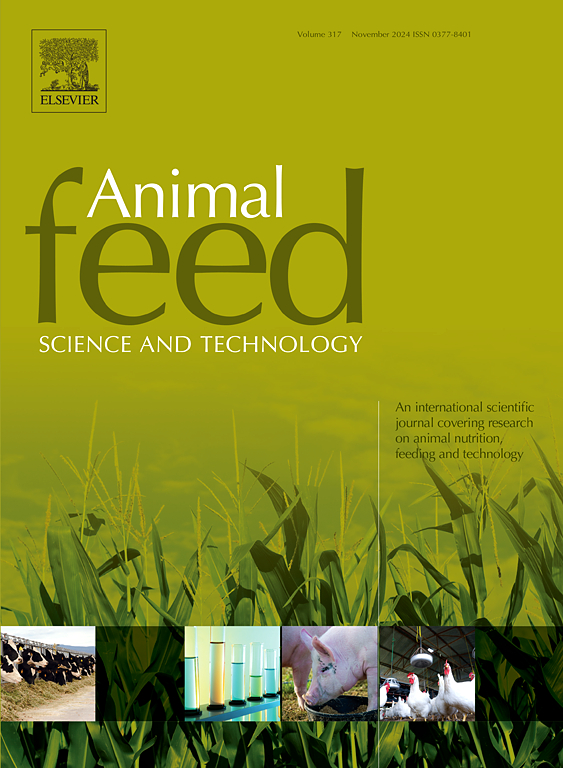欧洲鲈鱼(Dicentrarchus labrax)饲料中加入自产乙醇梭菌蛋白替代鱼粉蛋白的评价:生长性能、消化酶、健康状况和组织调查
IF 2.5
2区 农林科学
Q1 AGRICULTURE, DAIRY & ANIMAL SCIENCE
引用次数: 0
摘要
自乙醇衍生梭菌蛋白(CAP)是一种在农业副产品乙醇发酵过程中产生的微生物蛋白。本研究评估了在水产饲料中使用CAP作为减少对鱼粉(FM)依赖的可持续替代品。本研究对初始体重为10.5 ± 1.5 g的欧洲鲈幼鱼(Dicentrarchus labrax)进行了为期70天的饲养试验,以0 %(对照,CAP0)、10 % (CAP10)、20 % (CAP20)、30 % (CAP30)和50 % (CAP50)添加水平的CAP部分替代FM蛋白对饲料的影响。结果表明,饲粮中添加高达 %鱼粉替代量的CAP对生长性能、饲料效率和成活率没有显著影响(P >; 0.05)。同样,生长相关基因(IGF-1和GH)的表达水平在不同处理中保持不变。肠道消化酶(包括脂肪酶、α -淀粉酶和蛋白酶)活性以及血液学参数不受饲粮CAP添加水平的影响。组织学评估显示,饲喂含cap饲料的鱼的肠道、肝脏和脾脏组织结构正常。说明CAP对器官结构无不良影响。一项简单的经济分析表明,随着CAP添加量的增加,饲料成本降低,与对照饲料相比,每吨鱼增重的生产成本在替代50% % FM时降低了19.3 %。这些研究结果表明,CAP是一种可行且具有成本效益的蛋白质来源,能够在不影响拉布拉克斯幼鱼生长、健康状况或器官结构的情况下,在实际饮食中替代高达50% %的FM蛋白质。本文章由计算机程序翻译,如有差异,请以英文原文为准。
Evaluating the inclusion of Clostridium autoethanogenum protein instead of fishmeal protein in diets for European seabass (Dicentrarchus labrax): Growth performance, digestive enzymes, health status, and tissues investigations
The Clostridium autoethanogenum-derived protein (CAP) is a microbial protein generated during ethanol fermentation of agricultural byproducts. The present investigation evaluated the use of CAP as a sustainable alternative to reduce fishmeal (FM) dependency in aqua-feeds. A 70-day feeding trial was done to examine the impacts of partially replacing FM protein by CAP at 0 % (control, CAP0), 10 % (CAP10), 20 % (CAP20), 30 % (CAP30), and 50 % (CAP50) inclusion levels in diets for European seabass (Dicentrarchus labrax) juvenile (initial weight 10.5 ± 1.5 g). Results obtained demonstrated that dietary CAP incorporation up to 50 % FM replacement did not significantly (P > 0.05) impact the growth performance, feed efficiency, or survival rates. Similarly, the expression levels of growth-related genes (IGF-1 and GH) remained unchanged across treatments. The intestinal digestive enzymes activities, including lipase, alpha-amylase, and proteases, as well as the haematological parameters remained unaffected by the dietary CAP inclusion levels. Histological assessment revealed normal tissue architecture in the intestine, liver, and spleen of fish fed on CAP-containing diets. That indicats no adverse effects of CAP on organs’ structure. A simple economic analysis showed reduced feed costs with increasing CAP inclusion, where production costs per ton of fish gain decreases by 19.3 % at 50 % FM replacement compared to the control diet. These findings establish that CAP is a viable and cost-effective protein source capable of replacing up to 50 % FM protein in practical diets for D. labrax juveniles without compromising their growth, health status, or organs’ structure.
求助全文
通过发布文献求助,成功后即可免费获取论文全文。
去求助
来源期刊

Animal Feed Science and Technology
农林科学-奶制品与动物科学
CiteScore
6.00
自引率
6.20%
发文量
266
审稿时长
3 months
期刊介绍:
Animal Feed Science and Technology is a unique journal publishing scientific papers of international interest focusing on animal feeds and their feeding.
Papers describing research on feed for ruminants and non-ruminants, including poultry, horses, companion animals and aquatic animals, are welcome.
The journal covers the following areas:
Nutritive value of feeds (e.g., assessment, improvement)
Methods of conserving and processing feeds that affect their nutritional value
Agronomic and climatic factors influencing the nutritive value of feeds
Utilization of feeds and the improvement of such
Metabolic, production, reproduction and health responses, as well as potential environmental impacts, of diet inputs and feed technologies (e.g., feeds, feed additives, feed components, mycotoxins)
Mathematical models relating directly to animal-feed interactions
Analytical and experimental methods for feed evaluation
Environmental impacts of feed technologies in animal production.
 求助内容:
求助内容: 应助结果提醒方式:
应助结果提醒方式:


